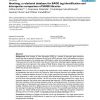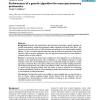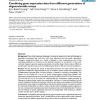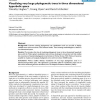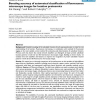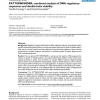BMCBI
2004
13 years 11 months ago
2004
BMCBI
2004
13 years 11 months ago
2004
Background: It is a major challenge of computational biology to provide a comprehensive functional classification of all known proteins. Most existing methods seek recurrent patte...
BMCBI
2004
13 years 11 months ago
2004
Background: Multi-locus sequence typing (MLST) is a method of typing that facilitates the discrimination of microbial isolates by comparing the sequences of housekeeping gene frag...
BMCBI
2004
13 years 11 months ago
2004
Background: Due to the high cost and low reproducibility of many microarray experiments, it is not surprising to find a limited number of patient samples in each study, and very f...
BMCBI
2004
13 years 11 months ago
2004
Background: Recently, mass spectrometry data have been mined using a genetic algorithm to produce discriminatory models that distinguish healthy individuals from those with cancer...
BMCBI
2004
13 years 11 months ago
2004
Background: One of the important challenges in microarray analysis is to take full advantage of previously accumulated data, both from one's own laboratory and from public re...
BMCBI
2004
13 years 11 months ago
2004
Background: Common existing phylogenetic tree visualisation tools are not able to display readable trees with more than a few thousand nodes. These existing methodologies are base...
BMCBI
2004
13 years 11 months ago
2004
Background: SNP genotyping typically incorporates a review step to ensure that the genotype calls for a particular SNP are correct. For high-throughput genotyping, such as that pr...
BMCBI
2004
13 years 11 months ago
2004
Background: Detailed knowledge of the subcellular location of each expressed protein is critical to a full understanding of its function. Fluorescence microscopy, in combination w...
BMCBI
2004
13 years 11 months ago
2004
Background: Regulatory regions that function in DNA replication and gene transcription contain specific sequences that bind proteins as well as less-specific sequences in which th...
